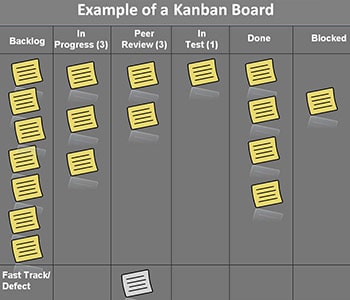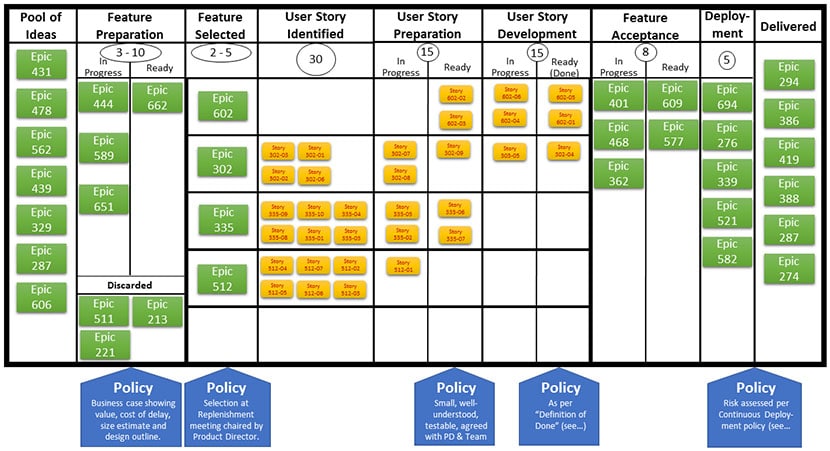
Kanban boards are organizing mechanisms used by firms to streamline workflows and maximize the productivity of the workforce. Amongst all available mainframe techniques, Kanbans are uncomplicated and can be smoothly implemented and utilized within an organization. In fact, companies urge their staff members to incorporate Kanban ideologies into their daily work cycle rather than halting operations for a mere process improvement.
Where did it originate?
In the 1940’s, Toyota came up with a strategy to regularize its manufacturing and technical processes. At that time it followed lean procedures so the workers made use of colored cards to transfer information about assembly areas which required improvement. This, in turn, helped in the accurate completion of tasks, and minimizes the wastage of resources.

In the Japanese language, the term Kanban denotes optical gestures (i.e. visible action). All visible actions are repeated to ensure continuous refinement of operational processes. Now, the Kanban framework has been adopted by corporations across many industries. Also, with the increasing number of start-ups, its implementation will increase simultaneously.
Classification of Kanban Board
They can be classified into two categories;
Best Charts, Graphs, and Diagram Tools
- 10 Best Online Chart Maker of 2023
- 10 Best Microsoft Visio Alternatives 2023
- 10 Best Org Chart Maker of 2023
- 10 Best UML Diagram Tools 2023
- 10 Best Entity Relationship Diagram (ERD) Tools 2023
1. Corporeal Kanban Framework
Corporeal means physical thus they are a physical representation of a virtual Kanban structure. Any team looking to map out their responsibilities and relationships with departments can use these boards. This, in turn, will increase the performance and time management skills of that team/department.
A physical Kanban is usually created on a whiteboards/blackboards and encompasses 3 to 4 columns depending upon the business. Each column has a title such as uncompleted work, pending work, the work in process and work is done. The movement of work is portrayed through sticky notes and illustrate the status of each task.
In comparison to digital Kanbans, the corporeal ones can be set up effortlessly. Also, since they are set up on whiteboards/blackboards they are more visible to large teams.
2. Digital Kanban Framework
A Digital Kanban Framework is majorly utilized in the technology sector and helps to streamline workflows within technical teams. Kanban is not limited to time and it only focuses on continuous completion of work and improvement of processes. This, in turn, ensures regular order delivery to customers and keeps them satisfied.
Under this framework, whiteboards are replaced by virtual checklists. Each checklist exhibits a phase of Kanban and is given a title like uncompleted work, pending work, work in process, and work done. This framework is visible to each team member and they can manage and access it accordingly.

This model comes with a lot of advantages such as;
- Team members located in different areas can view and manage this framework at their own pace and time.
- These are simple frameworks which have a user-friendly interface.
- Since tasks are divided into small parts the chances of amending are drastically reduced.
- Digital Kanban Frameworks can be personalized according to the requirements of the team. Team members can also suggest alternative solutions to complete pending tasks.
Facets of Kanban Structures
Optical Gestures (Visible Action): The visual actions are expressed on pieces of paper/ sticky notes. Each sticky note/ piece of paper contains one action regarding the project. Once all the actions are written they are arranged into their respective categories. Through these actions, each team member gains clarity about the process and actions that need to be performed on the individual as well as group levels.
Columns or Checklists: A typical Kanban structure will contain 3 to 4 columns. Each column has a title such as (uncompleted work, pending work, work in process, and work done). Representing different segments of the project. The sticky notes are placed in these categories to organize the work pattern of the team and continue until the project ends.
Work In Progress (WIP) Capping: Each column in the framework can contain a certain number of actions at a time. The Work in Progress capping helps to balance out the number of actions in each column. Usually only or maximum 4 sticky note actions can be kept in each column. In order to add more activities, the team must complete the previous activities systematically. WIP capping also helps to identify roadblocks at an early stage so the teams can think of alternative solutions to execute those actions.
Commitment Point: Under the category uncompleted work team members can contribute plans for new projects as well as suggestions to improve existing ones. The moment of commitment occurs when a plan or suggestion is adopted by the team and actions begin.
Final Touch Down: This is the place where all activities end. The most common example is when a product reaches the customer the chain of workflow ends. The overall objective of the team is to complete each action within less time (i.e. moving the sticky notes from a commitment point to the final touch down). The time taken to complete each action is referred to as lead time.
How to develop a Kanban Framework?
Kanban is a process improvement technique so the Kanban team will be aware of the areas which need enhancement and perfection. However, to implement a Kanban framework the team must consider three points:
- A team must segment the project into columns. Each column will contain a limited number of actions. After an action is completed it is replaced by a new action. Thus, moving a step forward towards goal completion.
- Before creating action cards the Kanban team should know what aspect of the project it will cover. In addition, an estimate of the difficulty and time required to complete each action will help them to achieve it effectively.
- Deciding upon the commitment and final touch down points is also crucial. After which you can initiate action. However, it is not necessary that all things will go as planned so suggestions from the team should be taken to enhance existing work-flow processes.
Finally, taking note of all the points will help develop Kanban models which are speedy and provide continuous improvement possibilities.
